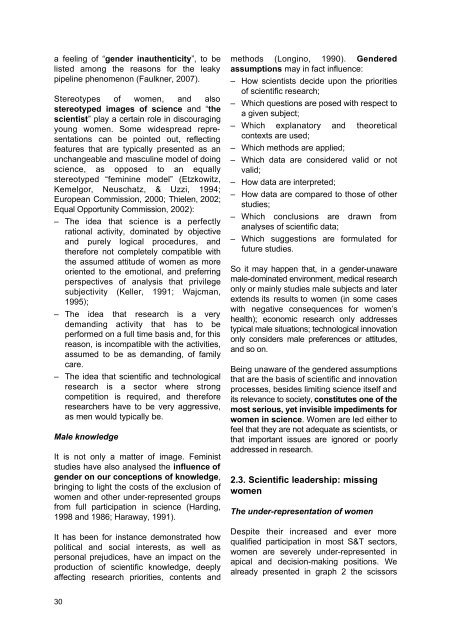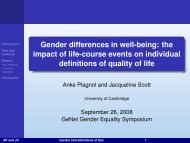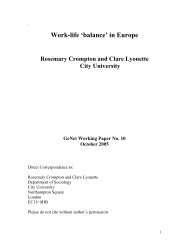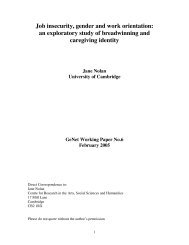Guidelines for Gender Equality Programmes in Science - GeNet
Guidelines for Gender Equality Programmes in Science - GeNet
Guidelines for Gender Equality Programmes in Science - GeNet
Create successful ePaper yourself
Turn your PDF publications into a flip-book with our unique Google optimized e-Paper software.
a feel<strong>in</strong>g of “gender <strong>in</strong>authenticity”, to be<br />
listed among the reasons <strong>for</strong> the leaky<br />
pipel<strong>in</strong>e phenomenon (Faulkner, 2007).<br />
Stereotypes of women, and also<br />
stereotyped images of science and “the<br />
scientist” play a certa<strong>in</strong> role <strong>in</strong> discourag<strong>in</strong>g<br />
young women. Some widespread representations<br />
can be po<strong>in</strong>ted out, reflect<strong>in</strong>g<br />
features that are typically presented as an<br />
unchangeable and mascul<strong>in</strong>e model of do<strong>in</strong>g<br />
science, as opposed to an equally<br />
stereotyped “fem<strong>in</strong><strong>in</strong>e model” (Etzkowitz,<br />
K e m e l g o r, Neuschatz, & Uzzi, 1994;<br />
European Commission, 2000; Thielen, 2002;<br />
Equal Opportunity Commission, 2002):<br />
– The idea that science is a perfectly<br />
rational activity, dom<strong>in</strong>ated by objective<br />
and purely logical procedures, and<br />
there<strong>for</strong>e not completely compatible with<br />
the assumed attitude of women as more<br />
oriented to the emotional, and preferr<strong>in</strong>g<br />
perspectives of analysis that privilege<br />
subjectivity (Keller, 1991; Wa j c m a n ,<br />
1995);<br />
– The idea that research is a very<br />
demand<strong>in</strong>g activity that has to be<br />
per<strong>for</strong>med on a full time basis and, <strong>for</strong> this<br />
reason, is <strong>in</strong>compatible with the activities,<br />
assumed to be as demand<strong>in</strong>g, of family<br />
care.<br />
– The idea that scientific and technological<br />
research is a sector where strong<br />
competition is required, and there<strong>for</strong>e<br />
researchers have to be very aggressive,<br />
as men would typically be.<br />
Male knowledge<br />
It is not only a matter of image. Fem<strong>in</strong>ist<br />
studies have also analysed the <strong>in</strong>fluence of<br />
gender on our conceptions of knowledge,<br />
br<strong>in</strong>g<strong>in</strong>g to light the costs of the exclusion of<br />
women and other under-represented groups<br />
from full participation <strong>in</strong> science (Hard<strong>in</strong>g,<br />
1998 and 1986; Haraway, 1991).<br />
It has been <strong>for</strong> <strong>in</strong>stance demonstrated how<br />
political and social <strong>in</strong>terests, as well as<br />
personal prejudices, have an impact on the<br />
production of scientific knowledge, deeply<br />
a ffect<strong>in</strong>g research priorities, contents and<br />
methods (Long<strong>in</strong>o, 1990). G e n d e r e d<br />
assumptions may <strong>in</strong> fact <strong>in</strong>fluence:<br />
– How scientists decide upon the priorities<br />
of scientific research;<br />
– Which questions are posed with respect to<br />
a given subject;<br />
– Which explanatory and theoretical<br />
contexts are used;<br />
– Which methods are applied;<br />
– Which data are considered valid or not<br />
valid;<br />
– How data are <strong>in</strong>terpreted;<br />
– How data are compared to those of other<br />
studies;<br />
– Which conclusions are drawn from<br />
analyses of scientific data;<br />
– Which suggestions are <strong>for</strong>mulated <strong>for</strong><br />
future studies.<br />
So it may happen that, <strong>in</strong> a gender-unaware<br />
male-dom<strong>in</strong>ated environment, medical research<br />
only or ma<strong>in</strong>ly studies male subjects and later<br />
extends its results to women (<strong>in</strong> some cases<br />
with negative consequences <strong>for</strong> women’s<br />
health); economic research only addresses<br />
typical male situations; technological <strong>in</strong>novation<br />
only considers male preferences or attitudes,<br />
and so on.<br />
Be<strong>in</strong>g unaware of the gendered assumptions<br />
that are the basis of scientific and <strong>in</strong>novation<br />
processes, besides limit<strong>in</strong>g science itself and<br />
its relevance to society, constitutes one of the<br />
most serious, yet <strong>in</strong>visible impediments f o r<br />
women <strong>in</strong> science. Women are led either to<br />
feel that they are not adequate as scientists, or<br />
that important issues are ignored or poorly<br />
addressed <strong>in</strong> research.<br />
2.3. Scientific leadership: miss<strong>in</strong>g<br />
women<br />
The under-representation of women<br />
Despite their <strong>in</strong>creased and ever more<br />
qualified participation <strong>in</strong> most S&T sectors,<br />
women are severely under-represented <strong>in</strong><br />
apical and decision-mak<strong>in</strong>g positions. We<br />
already presented <strong>in</strong> graph 2 the scissors<br />
30






